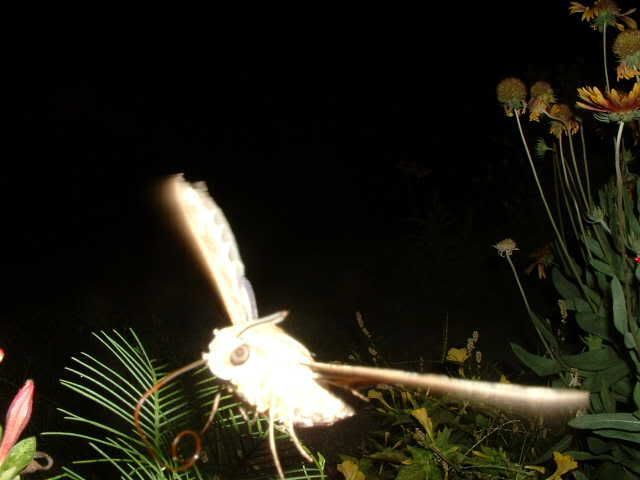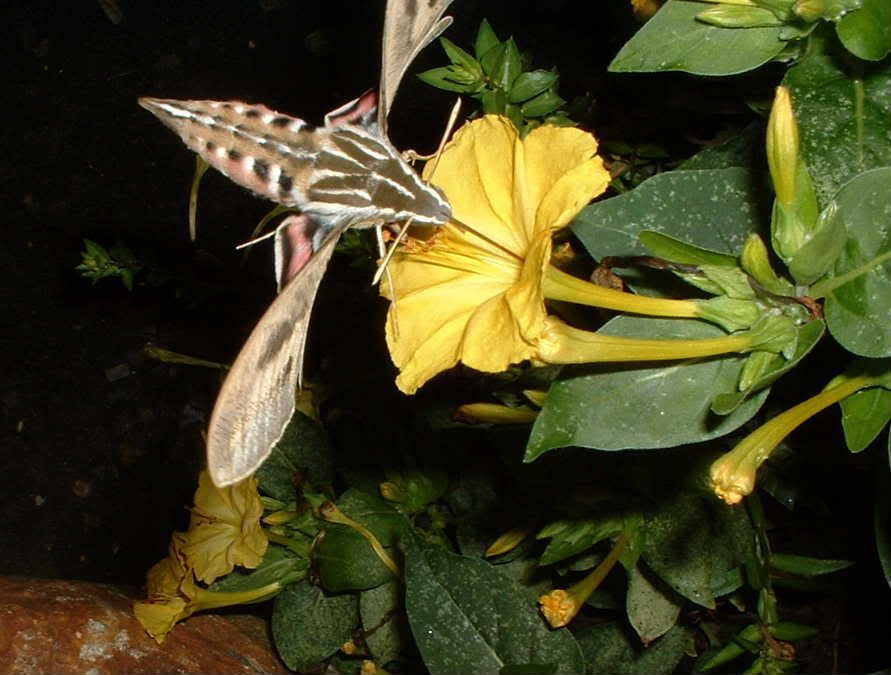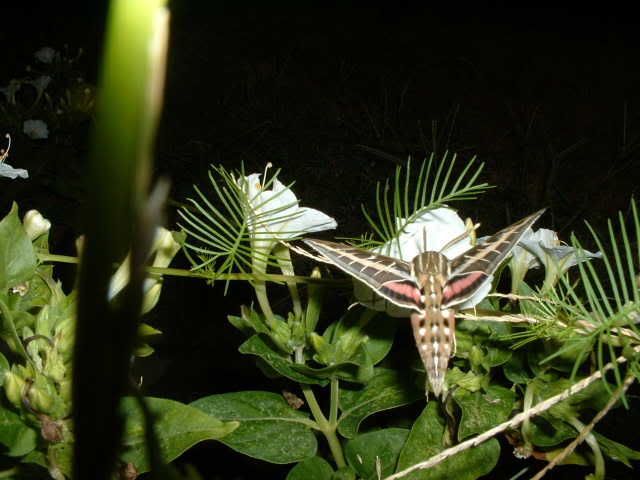



 Watch out Tokyo!
Watch out Tokyo!Sphinx moths are positively drawn to deep throated night blooming flowers who offer an ample feast of nectar for these industrious beauties, so supplying them with numerous specimens of Four O'clocks, Moonflowers and other nectar laden flowers is almost sure to draw them to your garden in the early evening hours just before dusk and later ....
We did a little research tonight on these magnificent little guys (well, they're not that little, they are usually about 2.5 - 3.0 inches long with a similar wingspan) and here's what we found out:
Their natural habitat ranges from southern Canada (yes, Olivia, you must have them somewhere!) to Central America and from the Atlantic to Pacific oceans. Basically, just about anywhere in the U.S.
The larval stage is often called a green "Horned worm" which can sometimes be found on tomatoes, upon which they apparently are known to feast. Other food for the caterpillars includes common portulaca (aka: purslane), chickweed and other leafy green plants commonly found in most gardens and yards.
Given that they take wing in mid-summer, we surmised that they must mate in the fall, lay their eggs, which then overwinter until the larvae emerge as caterpillars sometime in the spring. Though there are a lot of icky green worms that you can find on your tomatoes, if you find a largish green one with pronounced horns and two red spots on either side of the head, consider sparing it, as you may later be rewarded with the magical adults later in the summer. We don't seem to find them on our tomatoes, but given when they must be in the larval stage, I think they must feed on other things in our yard ... and it does make sense that you would be more likely to find these on your tomatoes in a more southern climate where they are planted much earlier than we do here in Zone 5.
When I was kid, I often mistook these wondrous moths for hummingbirds, and it's not an uncommon mistake, given how they hover over their food and take flight at the slightest disturbance. There is, however, a species called Clear Wing Hummingbird Moth which I recently saw HERE on FarFetched'sTales From Far Manor site. Thanks for reminding me of the magical beauty of these large moths, Far! I knew I'd eventually get around to posting about our Sphixies, but you got me digging for the materials and got me thinking about them again ... late summer pleasure that they are when they choose to visit and bring their magical drama to a garden near you ....
And for you MOTHRA fans out there, here's a fun link to her oeuvre.
If you're a diehard Mothra fan as I am, you'll find she has been quite the resiliant moth after all these years, despite her rattier look in the late 1960's, she's still a beauty in my eyes! Enjoy ....









7 comments:
This is a wonderful post and pictures IVG. I haven't been on the computer too much this weekend, and I start this morning and see this. What a great way to start Monday. :)
Gorgeous moths IVG! And thanks for all that info (you know how I love research ... hehe).
I can't recall seeing the moths here, but I know I've seen those LG green caterpillars on tomato plants ... in fact, the two go hand-in-hand for me, b/c I've always found those green guys on tomato plants. My first remembrance of them, was as a little kid hanging out in my neighbour's yard -- he had the biggest garden to my little eyes back then, and I was scared to go into the tomato patch b/c of the caterpillars! Very interesting!
So, next year I should plant tomatoes, four-o'clocks, and ::crossing fingers:: moonflower ... and see what happens ... ;)
And I forgot to say to those photos are amazing ... especially the prob. in number 1 and number 4! Wow!
:~~~~~~~~~~~
(that's a long proboscis smiley ... :P)
Hey, I can stop tapping my toes too! :-D
Good pix, too. I don't think I've seen a moth quite like that, although I could have seen one on the move & not known.
Wow, these are amazing!! You must have a very fast lens to stop the wing motion like that. They are gorgeous. 2.5-3"? Gee if one of those ran into you, you'd know you'd been hit. Mercy!
Thanks for mentioning the proboscis, O. I wouldn't have noticed otherwise. I think you can see it in #2 also.
Do they make a lot of racket when they fly? I am blown away!!!
Hi Far and P4! Glad you stopped by to see our little friends here ... I'd be interested to learn if you have perhaps seen them where you are, given their amazing range of habitat.
You do have to be out at dusk to dark to catch them at work, but if you have the right things planted, they will come. In fact, Far, we have seen them feeding on the butterfly bushes, as well as the purple verbena out front ... pretty much anything a hummingbird might like, these guys like it too.
P4, I tried to leave a congratulatory comment at your site today, but Blogger ate my comment, alas. I'll come back and try to reconstitute it later, but best wishes on the new place! (Well, not exactly "new" and very much the same thing we did 6 yrs ago ourselves!) Consider yourself offered seeds from our garden as you expand your beds in the future ... we'll be collecting a lot of things soon, so don't be shy. And I'll make a special point of collecting celosia seeds in case you're interested in seeing what you can conjure up out your way!
The camera is just a lil ole Fuji FinePix 2250, but it does right by me, as far as I'm concerned! Catching these guys as I did is a real crap shoot ... as the numerous pics I have with a partial wing in the frame can prove, but when I can get them full on, the results are more than gratifying!
And I love those shots with the proboscis exposed... amazing how long they are and how well they can get right down to where they need to feed on the nectar! As for the sound they make when they fly by, it's a very pleasant whirring sound ... I have to admit though, I've always felt just a wee bit guilty taking these pics of them as the flash from the camera disorients them temporarily. Usually though, they just fly off, and if you leave them alone, they come back quickly and go about their business as usual.
No Mothra fans stopping by yet? Awwww.... :-)
z1w68y7t61 w8t45b5e43 y5f84b9s49 x6p88z2m68 l8u28w9a70 f7v28k9w89
Post a Comment